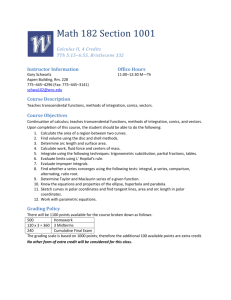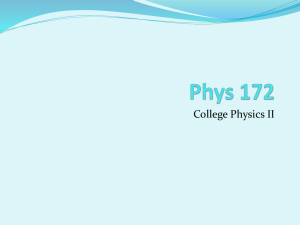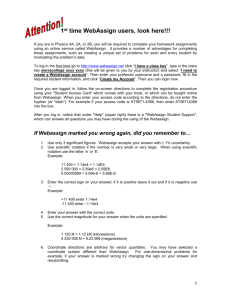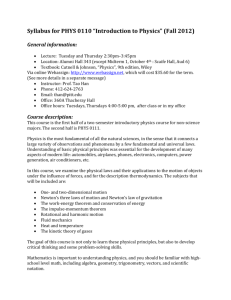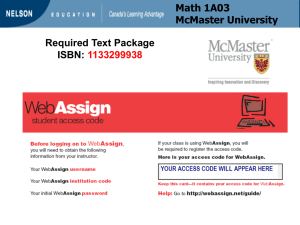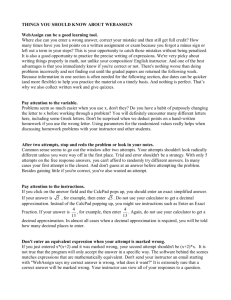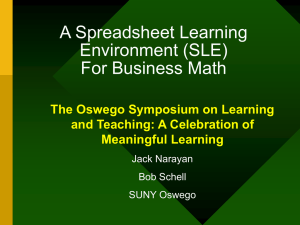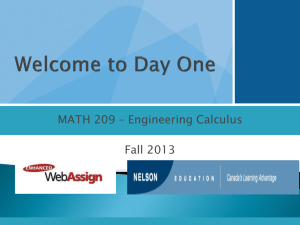GREENSHEET and Course outline for Math 31 (Calculus 2) Fall
advertisement
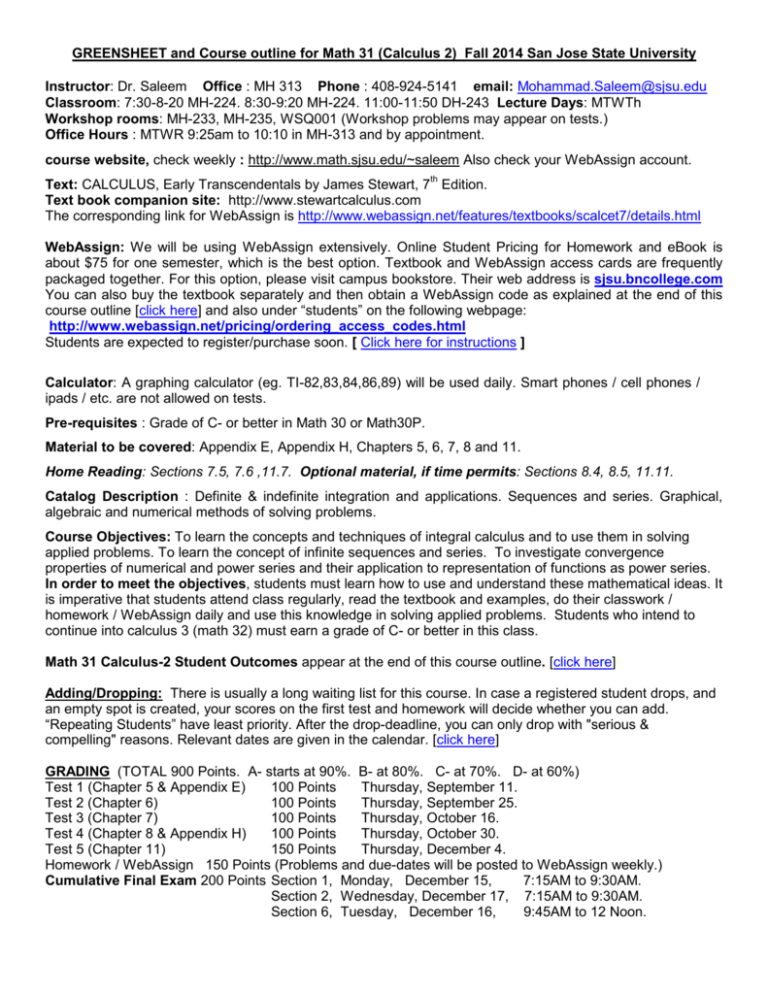
GREENSHEET and Course outline for Math 31 (Calculus 2) Fall 2014 San Jose State University Instructor: Dr. Saleem Office : MH 313 Phone : 408-924-5141 email: Mohammad.Saleem@sjsu.edu Classroom: 7:30-8-20 MH-224. 8:30-9:20 MH-224. 11:00-11:50 DH-243 Lecture Days: MTWTh Workshop rooms: MH-233, MH-235, WSQ001 (Workshop problems may appear on tests.) Office Hours : MTWR 9:25am to 10:10 in MH-313 and by appointment. course website, check weekly : http://www.math.sjsu.edu/~saleem Also check your WebAssign account. Text: CALCULUS, Early Transcendentals by James Stewart, 7th Edition. Text book companion site: http://www.stewartcalculus.com The corresponding link for WebAssign is http://www.webassign.net/features/textbooks/scalcet7/details.html WebAssign: We will be using WebAssign extensively. Online Student Pricing for Homework and eBook is about $75 for one semester, which is the best option. Textbook and WebAssign access cards are frequently packaged together. For this option, please visit campus bookstore. Their web address is sjsu.bncollege.com You can also buy the textbook separately and then obtain a WebAssign code as explained at the end of this course outline [click here] and also under “students” on the following webpage: http://www.webassign.net/pricing/ordering_access_codes.html Students are expected to register/purchase soon. [ Click here for instructions ] Calculator: A graphing calculator (eg. TI-82,83,84,86,89) will be used daily. Smart phones / cell phones / ipads / etc. are not allowed on tests. Pre-requisites : Grade of C- or better in Math 30 or Math30P. Material to be covered: Appendix E, Appendix H, Chapters 5, 6, 7, 8 and 11. Home Reading: Sections 7.5, 7.6 ,11.7. Optional material, if time permits: Sections 8.4, 8.5, 11.11. Catalog Description : Definite & indefinite integration and applications. Sequences and series. Graphical, algebraic and numerical methods of solving problems. Course Objectives: To learn the concepts and techniques of integral calculus and to use them in solving applied problems. To learn the concept of infinite sequences and series. To investigate convergence properties of numerical and power series and their application to representation of functions as power series. In order to meet the objectives, students must learn how to use and understand these mathematical ideas. It is imperative that students attend class regularly, read the textbook and examples, do their classwork / homework / WebAssign daily and use this knowledge in solving applied problems. Students who intend to continue into calculus 3 (math 32) must earn a grade of C- or better in this class. Math 31 Calculus-2 Student Outcomes appear at the end of this course outline. [click here] Adding/Dropping: There is usually a long waiting list for this course. In case a registered student drops, and an empty spot is created, your scores on the first test and homework will decide whether you can add. “Repeating Students” have least priority. After the drop-deadline, you can only drop with "serious & compelling" reasons. Relevant dates are given in the calendar. [click here] GRADING (TOTAL 900 Points. A- starts at 90%. B- at 80%. C- at 70%. D- at 60%) Test 1 (Chapter 5 & Appendix E) 100 Points Thursday, September 11. Test 2 (Chapter 6) 100 Points Thursday, September 25. Test 3 (Chapter 7) 100 Points Thursday, October 16. Test 4 (Chapter 8 & Appendix H) 100 Points Thursday, October 30. Test 5 (Chapter 11) 150 Points Thursday, December 4. Homework / WebAssign 150 Points (Problems and due-dates will be posted to WebAssign weekly.) Cumulative Final Exam 200 Points Section 1, Monday, December 15, 7:15AM to 9:30AM. Section 2, Wednesday, December 17, 7:15AM to 9:30AM. Section 6, Tuesday, December 16, 9:45AM to 12 Noon. Study Habits: In this 4-unit course, students are expected to spend 8 to 12 hours per week outside of class (studying and doing homework). You must pay attention in class and use WebAssign to keep a record of all the homework problems. We will discuss solutions to some problems, but not all. You will learn best if you think hard about a problem and write a partial solution before you see an answer. WebAssign is somewhat forgiving on homework, but don’t misuse it. It is obvious that “you learn math by doing it and not by watching the instructor solve problems on the board”. You will notice that time spent on a homework pays off during a test, especially because many homework problems may show up on tests. Tutoring centers: “peer connections” http://peerconnections.sjsu.edu/ and Math-Lab MH-221 Make-up exams and quizzes: You will receive a “zero-score” for missing a test. There will be no "makeups". In case of unusual circumstances you must contact me before the exam (via phone, message, inperson-note, ...). Proof of sickness, accident, brother’s wedding, “my car broke down just before the exam” etc., will be required. If I accept your reason for missing a test as "valid", then your next test’s grade will be counted in place of a missed test. Our pace will be about "one section per day", so, if you are left behind for some reason, be prepared to “catch up” at your own risk. An “Incomplete” grade will not be given on basis of poor performance in the course. Workshops: In the past, students who participated regularly in precalculus and calculus workshops, have passed their courses 75% to 80% of the time; while students who did not take workshops, passed their courses about 40% of the time. Therefore, all students are strongly encouraged to take Math 31W. In these workshops, students work in small groups and solve problems, to help build their skills and confidence in problem solving. A workshop meets for 75-minutes, twice a week. More information about workshops can be found at the website, http://www.sjsu.edu/math/calculus/workshops/ Cheating: The campus academic integrity policy requires you to be honest in all your academic course work. Cheating on any quiz or exam may result in an F grade in the course. On homework you can consult with other students on general matters. A copied homework is cheating. On tests, exposing your work so others can copy, is also cheating. Students are expected to be aware of the Academic Integrity Policy at SJSU. The policy on academic integrity can be found at: http://www.sjsu.edu/studentconduct/docs/Academic_Integrity_Policy_S07-2.pdf Academic integrity statement (from Office of Judicial Affairs): “Your own commitment to learning, as evidenced by your enrollment at San José State University, and the University’s Academic Integrity Policy requires you to be honest in all your academic course work. Faculty are required to report all infractions to the Office of Judicial Affairs.” Disability: If you need course adaptations or accommodations because of a disability, please see the instructor privately or during regular office hours. The Disability Resource Center, DRC, is now called Accessible Education Center, AEC, phone (408) 924-6000, website: http://www.sjsu.edu/aec/ Campus policy in compliance with the Americans with Disabilities Act: “If you need course adaptations or accommodations because of a disability, or if you need special arrangements in case the building must be evacuated, please make an appointment with your instructors as soon as possible, or see them during office hours. Presidential Directive 97-03 requires that students with disabilities register with AEC to establish a record of their disability (http://www.sjsu.edu/aec/).” Class attendance According to University policy F69-24, “Students should attend all meetings of their classes, not only because they are responsible for material discussed therein, but because active participation is frequently essential to insure maximum benefit for all members of the class. Attendance per se shall not be used as a criterion for grading.” Important Dates can be found in the calendar [link for calendar] Math 31 Calculus-2 Student Outcomes At the end of the semester, a student should be able to 1. Apply the concepts and techniques of integral calculus in solving applied problems. 2. Use mathematical methods to solve quantitative problems, including those presented in verbal form 3. Use the concepts of definite integrals to solve problems involving area, volume, work, and other physical applications. 4. Use substitution, integration by parts, trigonometric substitution, partial fractions, and tables of antiderivatives to evaluate definite and indefinite integrals. 5. Use improper integrals. Apply the concepts of limits, convergence, and divergence to evaluate some classes of improper integrals. 6. Apply concepts of infinite sequences and series to determine convergence or divergence of sequences & series. 7. To investigate convergence properties of numerical and power series and their application to representation of functions as power series. 8. Use Taylor and MacLaurin series to represent functions and to integrate functions not integrable by conventional methods. 9. Use graphing calculators, mathematical software, etc., to solve standard calculus problems, specially numerical integration. [back] WebAssign instructions Go to the link https://www.webassign.net/login.html and locate one of these tabs to get started: I HAVE A CLASS KEY ENTER CLASS KEY Our class keys are Math-31, section (1) 7:30am, class key sjsu 7373 6052 Math-31, section (2) 8:30am, class key sjsu 9990 6719 Math-31, section (6) 11:00am, class key sjsu 9178 7235 The next screen will show the course as MATH-31 - Section 1, 2 or 6, instructor’s name as Dr. M Saleem and institution as San Jose State University. Go ahead and complete the registration process with this information. You have a grace period of two weeks. [back] WebAssign: Obtaining Access Codes WebAssign gives you a 14-day grace period to view and complete your homework without an access code. After 14 days, you will need a valid access code or you will be locked out of that course in WebAssign. Most codes are valid for one term. If a code is valid for a longer period of time, the duration is stated on the access code card. There are four ways to obtain an access code: 1. Purchase an access code online after logging into your WebAssign account. This method is the easiest because WebAssign automatically provides a correct code for each course. A credit card or PayPal account is needed for this option. 2. Purchase a textbook that is bundled with an Access Code Card, and enter the code after logging into WebAssign. Important! Before opening the access code, ensure that you purchased the correct textbook by checking that the prefix for your access card matches the textbook. If they do not match, please make sure that you purchased the correct textbook. If you did, then ask your instructor to ensure that the correct textbook has been selected in WebAssign. 3. Purchase an access code card separately at your bookstore, and enter the code after logging into WebAssign. For this option, before going to the bookstore, find the matching prefix for your textbook title to ensure that you purchase the correct Access Code Card. Enter the access code after logging into WebAssign. 4. Some institutions, particularly secondary schools, provide access code cards to students. Ask your instructor if you’re unsure. Refund Policy If a student drops a class, a refund can be requested within 14 days of the online purchase date. Please fill out the Request a Refund form to process this request. Note: WebAssign cannot provide refunds for printed textbooks or access code cards purchased from your campus bookstore. [back] Calendar Dr. Saleem / Calc-2 / Fall 2014 Department of Mathematics, SJSU Monday Tuesday Wednesday Thursday 11 - August 12 13 14 18 19 25 1st Day of Instruction One section of textbook a day 1 - September – Labor Day – Campus Closed 26 20 WebAssign accounts will become active 27 21 1st Duty Day 9:00 Dean’s meeting Friday Math Faculty Mtg 28 2 3 4 Friday–Sept 5th Last Day to Drop without “W” grade 8 9 15 16 10 Review for upcoming test If there is room, add-codes will be given after tomorrow’s test has been graded. 17 11 TEST Chapter 5 & Appendix E Friday 12th Last day to add courses & Register Late 18 22 23 25 29 30 24 Review for upcoming test 1 - October 6 7 8 9 13 14 15 Review for upcoming test 16 20 21 22 23 27 28 29 Review for upcoming test 3 - November 4 5 30 Chapter 8 & Appendix H Halloween 6 10 11 – Veteran’s Day – Campus Closed 12 13 17 18 19 20 24 25 26 – Classes after 5:00pm will not meet 27 Thanksgiving Holiday – Campus Closed 1 – December 2 3 Review for upcoming test 4 8 Review for Final Exam 9 Review for Final Exam 10 Last Day of instruction Review for Final Exam 11 - Dead Day; no classes 15 – Final Exam Section 1 7:15am to 9:30 16– Final Exam Section 6 9:45am to 12-noon 17– Final Exam Section 2 7:15am to 9:30 18 22 – Winter Recess – thru January 20, 2014 23 24 25 First day of classes January 22, 2015 Thursday TEST Chapter 6 2 TEST Chapter 7 TEST Chapter 11
